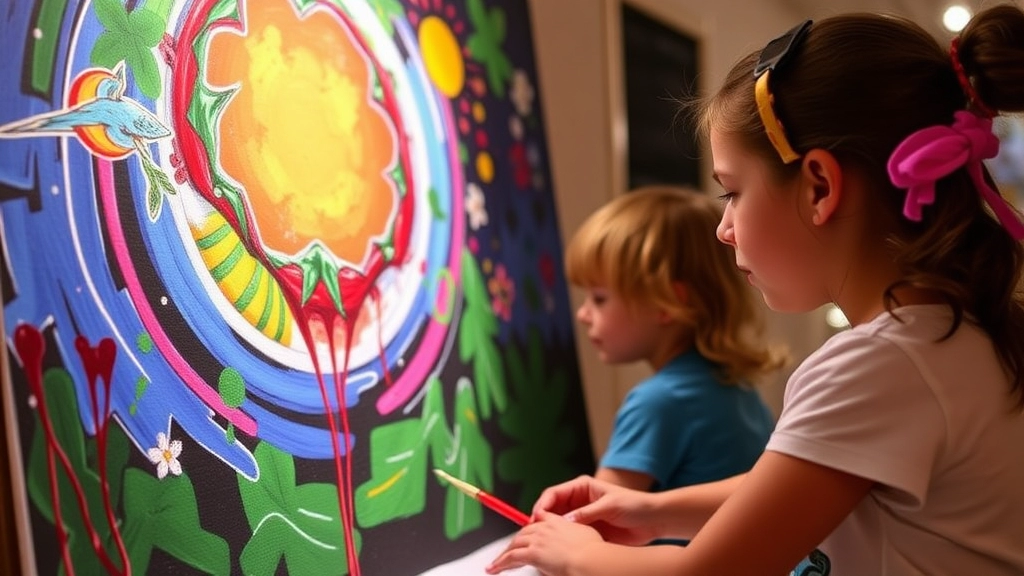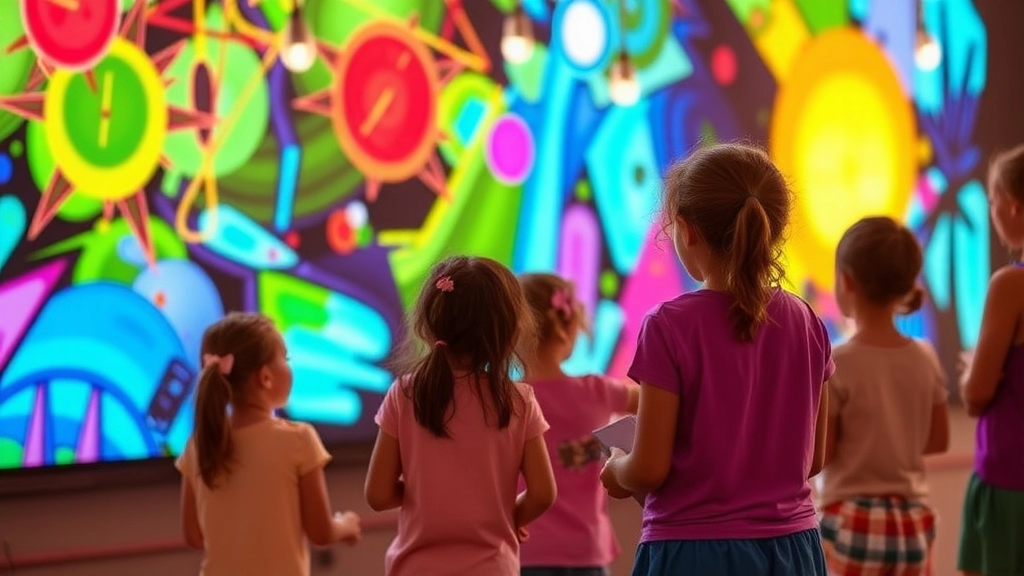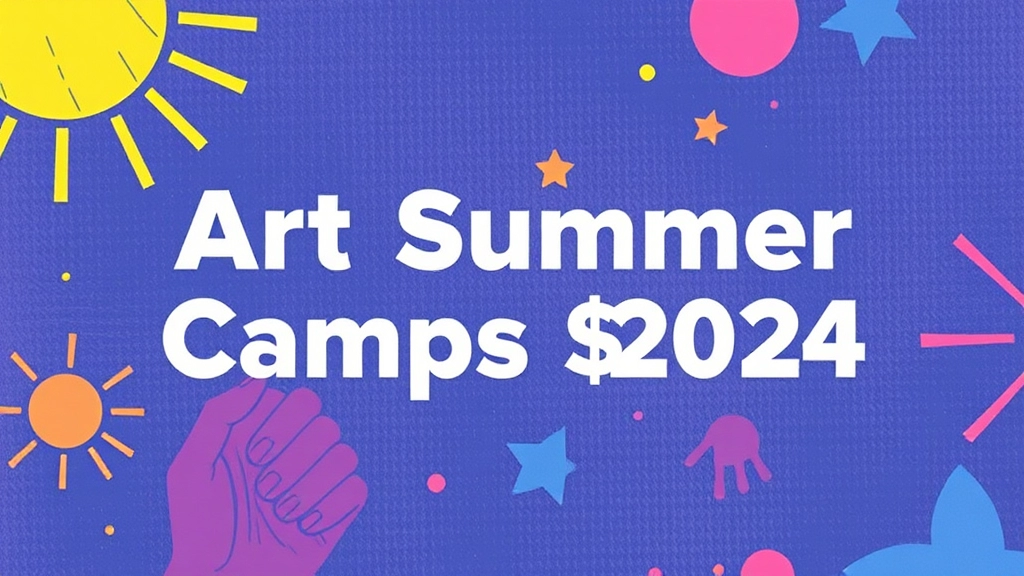Ignite Your Child’s Creativity This Summer
Looking for the perfect way to ignite your child’s creativity this summer? Art Summer Camps 2024 offer an incredible opportunity for kids and teens to explore various art forms, from painting and sculpture to digital arts. These camps are designed to balance structured learning with fun, often set in inspiring locations that fuel artistic expression. Whether your child is a budding artist or a seasoned creator, there’s a camp tailored to their skill level and interests.
Choosing the Right Art Camp
Choosing the right art camp can be a game-changer for your child’s summer. With options ranging from scenic outdoor settings to specialized studios, Art Summer Camps 2024 provide diverse experiences that cater to different age groups and artistic goals. Some camps even offer advanced programs for older students aiming for a career in the arts. Don’t miss out on this chance to give your child a summer filled with creativity and inspiration.
Choosing the Best Art Summer Camp for Your Child
When it comes to selecting the best art summer camp for your child, there are a myriad of factors to consider. As a parent, you want to ensure that the camp not only nurtures your child’s artistic abilities but also provides a safe and enriching environment. So, how do you go about making this crucial decision? Let’s break it down.
What Are Your Child’s Interests?
First and foremost, understand your child’s artistic interests. Are they passionate about painting, drawing, sculpture, or digital art? Knowing their preferences can help you narrow down the camps that specialise in those particular mediums.
Questions to Ask Your Child:
- What type of art do you enjoy the most?
- Are you interested in trying new art forms?
- Do you prefer group activities or solo projects?
Research the Camp’s Curriculum
Once you have a clear idea of your child’s interests, research the camp’s curriculum. Look for camps that offer a comprehensive program that aligns with your child’s artistic goals.
Key Points to Consider:
- Variety of Art Mediums: Does the camp offer a range of art forms?
- Skill Levels: Are there different levels for beginners, intermediate, and advanced students?
- Qualified Instructors: Are the instructors experienced and qualified in their respective fields?
Location and Duration
Location and duration are crucial factors to consider. Is the camp local, or will it require travel? How long is the camp session?
Factors to Consider:
- Proximity: Is the camp close to home, or will your child need to stay overnight?
- Duration: How long is the camp? Is it a week-long, two weeks, or a month?
- Daily Schedule: What does a typical day look like at the camp?
Safety and Supervision
Ensuring your child’s safety is paramount. Check the camp’s safety protocols and supervision policies.
Safety Checklist:
- Staff-to-Child Ratio: Is there adequate supervision?
- Emergency Procedures: What are the camp’s emergency protocols?
- Health and Safety Standards: Are the facilities clean and well-maintained?
Reviews and Testimonials
Reading reviews and testimonials from other parents and campers can provide valuable insights into the camp’s quality and environment.
What to Look For:
- Parent Reviews: What do other parents say about the camp?
- Camper Feedback: What are the experiences of past campers?
- Success Stories: Are there any notable success stories or achievements from the camp’s alumni?
Cost and Financial Aid
Let’s face it, the cost can be a significant factor. Compare the costs of different camps and check if they offer any scholarships or financial aid.
Budget Considerations:
- Tuition Fees: What is the cost of the camp?
- Additional Costs: Are there any extra fees for materials or activities?
- Financial Aid: Does the camp offer scholarships or financial assistance?
Choosing the best art summer camp for your child involves a careful balance of understanding their interests, researching the camp’s offerings, and considering practical factors like location and cost. By taking the time to evaluate these elements, you can ensure that your child has a rewarding and enriching summer experience.
If you’re looking for specific recommendations, you might want to explore the best art museum summer camps for kids or consider the top culinary arts camps for summer 2024 for a unique blend of creativity and learning.
Popular Art Camp Locations in 2024

Wondering where to send your budding artist this summer?
Let’s dive into the top art camp locations for 2024.
Why Location Matters
Choosing the right location can make or break your child’s summer camp experience.
You want a place that’s inspiring, safe, and full of opportunities for growth.
But where do you start?
Top Picks for 2024
Here are some of the best spots that should be on your radar:
1. New York City, USA
Why NYC?
- Diverse Art Scene: From street art to world-class museums, NYC has it all.
- Expert Instructors: Many camps feature instructors who are practicing artists or art professors.
- Networking: Your child will meet other young artists and potentially lifelong friends.
2. London, UK
Why London?
- Rich History: The city is a treasure trove of art history.
- Cultural Exposure: Visits to the Tate Modern, the National Gallery, and more.
- Workshops and Classes: London offers specialised camps focusing on everything from painting to digital art.
3. Paris, France
Why Paris?
- Artistic Heritage: Think of all the greats who’ve walked these streets—Monet, Picasso, Van Gogh.
- Inspirational Atmosphere: Imagine your child sketching by the Seine or visiting the Louvre.
- Language Skills: A bonus if your child is learning French.
4. Tokyo, Japan
Why Tokyo?
- Blend of Tradition and Modernity: From traditional Japanese art to cutting-edge digital art.
- Unique Opportunities: Camps often include manga and anime drawing classes.
- Cultural Immersion: A chance to experience a different way of life and artistic expression.
Real Talk: What Parents Worry About
Safety: Always a top concern. Make sure the camp has good reviews and proper safety protocols.
Cost: Art camps can be pricey. Look into scholarships and financial aid options.
Distance: Sending your child far away can be nerve-wracking. Check if the camp has good communication channels and emergency plans.
Art Mediums and Techniques Taught at Summer Camps
When it comes to choosing the right art summer camp for your child, one of the biggest questions parents face is: “What art mediums and techniques will my child learn?” It’s a valid concern. After all, the goal is to provide a rich, educational experience that fosters creativity and skill development. Let’s break down what you can expect.
Diverse Art Mediums
Art summer camps offer a variety of mediums to explore, ensuring that every young artist finds their niche. Here are some of the most common mediums taught:
- Drawing: From basic pencil sketches to advanced charcoal techniques, drawing is a staple in most art camps.
- Painting: Camps often cover a range of painting styles, including watercolour, acrylic, and oil painting.
- Sculpture: Working with clay, wood, or even recycled materials, children learn the fundamentals of three-dimensional art.
- Digital Art: With technology becoming increasingly important, many camps now include digital art, using software like Adobe Photoshop or Illustrator.
- Printmaking: Techniques such as linocut, etching, and screen printing introduce kids to the world of printmaking.
Fundamental Techniques
Understanding the mediums is just half the battle. The techniques taught at these camps are equally crucial. Here’s what your child might learn:
- Basic Drawing Techniques: Shading, perspective, and proportion are foundational skills in drawing.
- Colour Theory: Learning about primary, secondary, and tertiary colours, as well as how to mix and match them.
- Brush Handling: Different brush strokes and their effects in painting.
- Sculpting Methods: Techniques like coiling, slab building, and carving.
- Digital Skills: Layering, digital painting, and vector graphics in digital art.
Specialised Workshops
Many art camps go beyond the basics to offer specialised workshops. These can include:
- Portrait Drawing: Focusing on capturing human expressions and anatomy.
- Landscape Painting: Techniques for creating vivid, realistic landscapes.
- Mixed Media: Combining different materials and techniques to create unique artworks.
- Animation: Basics of creating animated sequences, often using stop-motion or digital animation tools.
Real-Life Examples
Imagine your child coming home with a beautifully detailed charcoal portrait, or a vibrant acrylic landscape painting. These are not just art pieces; they are tangible proof of the skills and techniques your child has mastered. One parent shared how their child, initially interested only in drawing, discovered a passion for sculpture after a summer camp workshop. This kind of exploration is invaluable.
Preparing for the Experience
Before sending your child off, it’s essential to prepare them for the diverse range of activities they’ll encounter. Here are a few tips:
- Supply List: Most camps provide a list of required supplies. Make sure to get these in advance.
- Practice Basics: If possible, let your child practice some basic techniques at home to build confidence.
- Open Mindset: Encourage your child to be open to trying new mediums and techniques.
By understanding the art mediums and techniques taught at summer camps, you can make an informed decision that will enrich your child’s artistic journey. For more information on the best art camps available, check out our guide to art museum summer camps and explore the NYSA summer camp art programs.
Scholarships and Financial Aid for Art Camps

Worried about the cost of art summer camps?
You’re not alone.
Many parents feel the pinch when looking at those hefty price tags.
But here’s the good news: scholarships and financial aid are out there.
Let’s dive into how you can snag some of that cash to make your child’s artistic dreams come true.
Why Consider Scholarships?
First off, scholarships can significantly reduce the financial burden.
Imagine not having to worry about how to pay for your child’s creative journey.
Sounds good, right?
But how do you actually find these scholarships?
Where to Look for Scholarships
- Camp Websites: Many camps offer their own scholarships. Check their websites for details.
- Local Art Organisations: Sometimes, local art groups have funds set aside for budding artists.
- Schools: Your child’s school might have information on available scholarships.
- Online Platforms: Websites like Scholarship.com list various opportunities.
Types of Financial Aid
Financial aid isn’t just one-size-fits-all.
Here are some types you might come across:
- Merit-Based Scholarships: Awarded for exceptional talent.
- Need-Based Aid: Based on your financial situation.
- Grants: Often from art organisations or foundations.
How to Apply
Applying for scholarships and financial aid can feel like a full-time job.
But it’s worth it.
Here’s a quick rundown:
- Gather Documents: You’ll need things like tax returns, proof of income, and maybe a portfolio of your child’s work.
- Write a Killer Essay: Some applications require an essay. Make it personal and compelling.
- Meet Deadlines: Mark those dates on your calendar. Late applications are a no-go.
Real-Life Example
Let’s talk about Sarah, a single mum from Manchester.
She was worried she couldn’t afford an art camp for her daughter.
But she found a need-based scholarship through the camp’s website.
She applied, and guess what?
Her daughter got in, and the scholarship covered 75% of the cost.
Virtual vs. In-Person Art Summer Camps
When it comes to choosing between virtual and in-person art summer camps, parents often find themselves juggling a myriad of questions and concerns. Which option offers the best experience for my child? Will the quality of instruction be the same? How do these formats affect social interaction and skill development? Let’s break it down to help you make an informed decision.
The Virtual Art Camp Experience
Convenience and Accessibility
Virtual art camps have surged in popularity, particularly in recent years. One of the most significant advantages is convenience. Your child can participate from the comfort of your home, eliminating the need for travel. This is especially beneficial for families living in remote areas or those with busy schedules.
Flexibility
Virtual camps often offer more flexible schedules. Many programs provide recorded sessions, allowing your child to learn at their own pace. This flexibility can be a game-changer for families juggling multiple commitments.
Diverse Offerings
Online platforms can bring together instructors and students from around the globe. This means your child could be learning from a renowned artist based in another country, something that might not be possible with local, in-person camps.
Potential Drawbacks
- Limited Hands-On Guidance: One of the main concerns is the lack of immediate, hands-on guidance. While instructors can provide feedback via video, it’s not quite the same as having someone physically present.
- Screen Fatigue: Extended periods of screen time can lead to fatigue, which might affect your child’s engagement levels.
The In-Person Art Camp Experience
Immersive Environment
In-person camps offer an immersive environment that can be incredibly beneficial for young artists. The physical presence of peers and instructors creates a dynamic and interactive learning atmosphere.
Hands-On Learning
Nothing beats the tactile experience of working with different art mediums. In-person camps provide the opportunity for hands-on learning, allowing children to experiment with various techniques under the immediate supervision of experienced instructors.
Social Interaction
One of the standout benefits of in-person camps is the social interaction. Your child will have the chance to make new friends, collaborate on projects, and develop social skills that are just as important as artistic skills.
Potential Drawbacks
- Geographical Limitations: Finding a high-quality art camp nearby can be challenging, especially if you live in a rural area.
- Cost and Time: The cost of travel and the time commitment required can be significant factors to consider.
Making the Right Choice
Ultimately, the choice between virtual and in-person art summer camps depends on your family’s specific needs and circumstances. Here are a few points to consider:
- Your Child’s Learning Style: Does your child thrive in social settings, or do they prefer independent learning?
- Budget and Time Constraints: What are your financial and time limitations?
- Artistic Goals: What are your child’s artistic aspirations? Do they require specialised equipment or guidance that might be more accessible in-person?
If you’re looking for a comprehensive guide to help you navigate the options, check out our Top Art Camps for Summer 2024. And for those interested in a more immersive experience, our Creative Summer Camp Art Ideas for Kids and Teens can provide additional inspiration.
Benefits of Attending an Arts-Focused Summer Camp

Ever wonder if an arts-focused summer camp is worth it?
Let’s break it down.
1. Unleashing Creativity
First off, these camps are creativity gold mines.
Your child will dive into projects that push their boundaries.
They’ll experiment with different mediums and techniques.
Think painting, sculpture, digital art.
2. Building Confidence
Kids often struggle with self-esteem, right?
Creating something unique boosts their confidence.
They see their progress and feel proud.
3. Social Skills
Art camps bring together like-minded kids.
They’ll make friends with shared interests.
Collaboration on projects teaches teamwork.
4. Skill Development
It’s not just fun and games.
They’ll learn real skills.
From basic drawing to advanced techniques.
These skills can be a foundation for future careers.
5. Mental Health
Art is therapeutic.
It helps kids express emotions and reduce stress.
A creative outlet can be a game-changer for mental well-being.
6. Exposure to New Ideas
Camps often bring in guest artists and run workshops.
Your child will be exposed to new styles and perspectives.
It broadens their artistic horizons.
7. Structure and Discipline
Art camps have schedules and deadlines.
This teaches kids time management and discipline.
They learn to balance creativity with structure.
8. Portfolio Building
For older kids, it’s a chance to build a portfolio.
This can be crucial for college applications.
Or even for entering art competitions.
9. Fun and Adventure
Let’s not forget the fun part!
These camps are often set in beautiful locations.
There are outdoor activities and excursions too.
It’s a balanced mix of work and play.
Real Stories, Real Impact
I remember a parent telling me about their shy daughter.
She attended an art camp and came back transformed.
More confident, more expressive.
She even won an art competition at school.
That’s the power of these camps.
So, is it worth it?
Absolutely.
Art summer camps offer a unique blend of creativity, skill-building, and fun.
They can be a pivotal experience for your child.
How to Register and Prepare for Art Summer Camps 2024
Wondering how to get your child into the best art summer camp for 2024?
No stress. I’ve got you covered.
Let’s break it down step-by-step, so you can get your kiddo ready without a hitch.
Registration Process
First things first, registration.
You don’t want to miss out because you were late to the game.
Here’s what you need to do:
1. Research Early
- Start looking up camps now.
- Check reviews, talk to other parents, and visit websites.
2. Check Deadlines
- Camps have different registration deadlines.
- Mark them on your calendar.
3. Gather Necessary Info
- You’ll need basic details: your child’s age, interests, and any special needs.
- Some camps ask for a portfolio or art samples.
4. Fill Out Forms
- Online registration is common, but some camps still use paper forms.
- Double-check for any required signatures or additional documents.
5. Pay the Fee
- Some camps require a deposit up front.
- Keep an eye out for early bird discounts.
Preparing for Camp
Okay, you’ve registered. Now what?
Get your child ready to dive into the world of art.
1. Supplies List
- Most camps provide a list of required materials.
- Stock up on art supplies: sketchbooks, paints, brushes, etc.
2. Health and Safety
- Make sure your child’s vaccinations are up to date.
- Inform the camp about any allergies or medical conditions.
3. Practice at Home
- Encourage your child to practice different art techniques.
- This boosts their confidence and skills.
4. Packing Essentials
- Comfortable clothing that can get messy.
- Snacks and water bottle.
- Sunscreen and hat for outdoor activities.
5. Mental Prep
- Talk to your child about what to expect.
- Share stories of your own camp experiences to ease any anxiety.
Final Checklist
Before the big day:
- Double-check the camp’s contact information.
- Confirm drop-off and pick-up times.
- Make sure all forms and payments are completed.
- Pack a bag the night before.
Stories from the Trenches
I remember when I first sent my niece to an art camp.
She was nervous, but we went through these steps together.
By the time camp started, she was pumped and ready to create.
She came back with amazing artwork and a newfound love for painting.
Ready to get started?
Registering and preparing for an art summer camp in 2024 doesn’t have to be a hassle.
Just follow these steps, and you’ll set your child up for a fantastic experience.
For more information on the best camps, check out our guide on art museum summer camps for kids.
FAQs About Art Summer Camps 2024
What are the top locations for art summer camps in 2024?
The top locations for art summer camps in 2024 include New York City, USA; London, UK; Paris, France; and Tokyo, Japan. Each location offers unique opportunities and experiences for young artists.
Why is the location of an art camp important?
Choosing the right location is crucial as it can significantly impact your child’s experience. You want a place that is inspiring, safe, and full of opportunities for artistic growth.
What makes New York City a good choice for an art camp?
New York City boasts a diverse art scene, expert instructors, and excellent networking opportunities. It’s a vibrant environment where young artists can thrive.
What benefits do art camps in London offer?
London offers a rich history, cultural exposure, and specialised workshops and classes. It’s an ideal location for young artists to explore and develop their skills.
Why should I consider an art camp in Paris for my child?
Paris is renowned for its artistic heritage and inspirational atmosphere. It’s a fantastic place for young artists to immerse themselves in art and culture, with the added benefit of practicing French.
What unique opportunities does Tokyo provide for art campers?
Tokyo offers a blend of traditional and modern art, unique opportunities in manga and anime, and a chance for cultural immersion. It’s a dynamic environment for artistic exploration.
What should parents consider regarding safety at art camps?
Safety is a top concern. Ensure the camp has good reviews and proper safety protocols. It’s important to choose a camp that prioritises the well-being of its participants.
How can I afford an art summer camp for my child?
Scholarships and financial aid can significantly reduce the cost. Look into camp websites, local art organisations, schools, and online platforms for available scholarships and financial aid options.
What types of financial aid are available for art camps?
Financial aid can come in various forms, including merit-based scholarships, need-based aid, and grants from art organisations or foundations.
How do I apply for scholarships and financial aid for art camps?
Gather necessary documents, write a compelling essay if required, and ensure you meet all deadlines. It’s a process that requires effort but can be very rewarding.
What are the benefits of attending an arts-focused summer camp?
Benefits include unleashing creativity, building confidence, developing social skills, learning new techniques, improving mental health, exposure to new ideas, gaining structure and discipline, building a portfolio, and having fun adventures.
Can attending an art camp help my child’s future career?
Yes, the skills and experiences gained at an art camp can lay a strong foundation for a future career in the arts. It’s also an excellent opportunity for portfolio building, which is crucial for college applications and art competitions.
References
-
The New York Times: Summer Art Camps 2024
-
Artsy: The 5 Best Summer Art Camps for 2024
-
Scholarships.com: Art Scholarships

